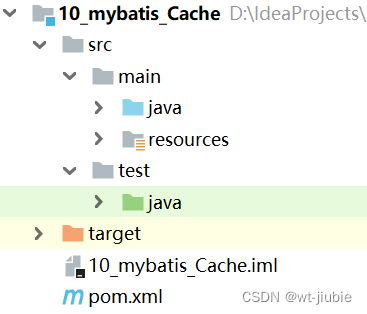MyBatis——MyBatis的动态SQL
发布时间:2023年12月25日
MyBatis的动态SQL
创建工程:

1.什么是动态SQL?
MyBatis的映射文件中支持在基础SQL上添加一些逻辑操作,并动态拼接成完整的SQL之后再执行,以达到SQL复用、简化编程的效果。
2.if标签
我们根据实体类的不同取值,使用不同的SQL语句来进行查询。比如在id如果不为空时可以根据 id查询,如果username不同空时还要加入用户名作为条件。这种情况在我们的多条件组合查询中经常会碰到。
-
mapper接口
public interface UserDao { //复杂条件查询 public List<User> findByUser(User user); } -
mapper映射文件
<?xml version="1.0" encoding="UTF-8"?> <!DOCTYPE mapper PUBLIC "-//mybatis.org//DTD Mapper 3.0//EN" "http://mybatis.org/dtd/mybatis-3-mapper.dtd"> <mapper namespace="com.wt.dao.UserDao"> <!--使用别名--> <select id="findByUser" resultType="User"> <!-- 1=1是为了永真,使得之后所有条件都不成立时where关键字后面有内容,防止报错--> select * from user where 1=1 <if test="username!=null and username != ''"> and username=#{username} </if> <if test="birthday!=null"> and birthday=#{birthday} </if> <if test="sex!=null and sex != ''"> and sex=#{sex} </if> <if test="address!=null and address != ''"> and address=#{address} </if> </select> </mapper> -
测试
@Test public void testFindAll(){ UserDao userDao = sqlSession.getMapper(UserDao.class); User user = new User(); user.setSex("男"); user.setAddress("香港"); List<User> userList = userDao.findByUser(user); for(User u : userList){ System.out.println(u); } }
3.where标签
为了简化上面where 1=1的条件拼装,我们可以使用where标签将if标签代码块包起来,将1=1条件去掉。
若查询条件的开头为 “AND” 或 “OR”,where 标签会将它们去除。
-
mapper映射文件
<?xml version="1.0" encoding="UTF-8"?> <!DOCTYPE mapper PUBLIC "-//mybatis.org//DTD Mapper 3.0//EN" "http://mybatis.org/dtd/mybatis-3-mapper.dtd"> <mapper namespace="com.by.dao.UserDao"> <select id="findByUser" resultType="User"> select * from user <!--where标签将if标签代码块包起来去掉开头 “AND” 或 “OR”--> <where> <if test="username!=null and username != ''"> and username=#{username} </if> <if test="birthday!=null"> and birthday=#{birthday} </if> <if test="sex!=null and sex != ''"> and sex=#{sex} </if> <if test="address!=null and address != ''"> and address=#{address} </if> </where> </select> </mapper>
4.set标签
set标签用于动态包含需要更新的列,并会删掉额外的逗号
-
mapper
public void updateByUser(User user);<update id="updateByUser" parameterType="user"> update user <set> <if test="username!=null and username != '' "> username=#{username}, </if> <if test="birthday!=null"> birthday=#{birthday}, </if> <if test="sex!=null and sex != '' "> sex=#{sex}, </if> <if test="address!=null and address != '' "> address=#{address}, </if> </set> where id=#{id} </update> -
测试
@Test public void testUpdateByUser(){ UserDao userDao = sqlSession.getMapper(UserDao.class); User user = new User(); user.setId(50); user.setBirthday(new Date()); user.setAddress("加拿大"); userDao.updateByUser(user); }
5.trim标签
trim标签可以代替where标签、set标签
-
mapper
//修改 public void updateByUser2(User user);<update id="updateByUser2" parameterType="User"> update user <!-- 增加SET前缀,忽略,后缀 --> <!-- trim标签一定要包括if标签,作用: prefix:加上前缀,“(” suffix:加上后缀,“)” prefixOverrides:去除多余的前缀内容 suffixOverrides:去除多余的后缀内容,“,” --> <trim prefix="SET" suffixOverrides=","> <if test="birthday!=null"> birthday=#{birthday}, </if> <if test="sex!=null and username != '' "> sex=#{sex}, </if> <if test="address!=null and username != '' "> address=#{address}, </if> </trim> where id=#{id} </update>
6.foreach标签
foreach标签的常见使用场景是集合进行遍历
-
mapper
//批量删除 public void deleteUserByIds(@Param("ids") List<Integer> ids); //批量添加 public void insertUsers(@Param("userList") List<User> userList);<delete id="deleteUserByIds" parameterType="list"> delete from user where id in <!-- collection:取值list、array、map、@Param("keyName")、对象的属性名 item:循环取出的具体对象 open:起始符 separator:分隔符 close:结束符 --> <foreach collection="ids" item="id" open="(" close=")" separator=","> #{id} </foreach> </delete> <insert id="insertUsers" parameterType="list"> INSERT INTO user(username,password,birthday,sex,address) VALUES <foreach collection ="userList" item="user" separator =","> (#{user.username},#{user.password},#{user.birthday}, #{user.sex},#{user.address}) </foreach> </insert> -
测试
@Test public void testDeleteUserByIds(){ UserDao userDao = sqlSession.getMapper(UserDao.class); List<Integer> ids = new ArrayList(); ids.add(50); ids.add(64); ids.add(67); userDao.deleteUserByIds(ids); } //通过将数据放入集合中使用forEach标签来执行sql语句,要比执行多次sql语句要更加省时 @Test public void testInsertUsers(){ UserDao userDao = sqlSession.getMapper(UserDao.class); long start = System.currentTimeMillis(); List<User> userList = new ArrayList<>(); for(int i = 0 ;i < 10000; i++) { User user = new User(); user.setUsername("刘德华"); user.setPassword("111"); user.setBirthday(new Date()); user.setSex("男"); user.setAddress("香港"); //userDao.insertUser(user); userList.add(user); } userDao.insertUsers(userList); long end = System.currentTimeMillis(); System.out.println("一万条数据总耗时:" + (end-start) + "ms" ); sqlSession.commit(); }
7.sql标签
sql元素标签用来定义可重复使用的SQL代码片段,使用时只需要用include元素标签引用即可
-
mapper
//复杂条件查询 public List<User> findByUser3(User user);<!-- 定义SQL片段 --> <sql id="query_user_where"> <if test="username!=null and username != ''"> and username=#{username} </if> <if test="birthday!=null"> and birthday=#{birthday} </if> <if test="sex!=null and sex != ''"> and sex=#{sex} </if> <if test="address!=null and address != ''"> and address=#{address} </if> </sql> <select id="findByUser3" resultType="User"> select * from user <where> <include refid="query_user_where"></include> </where> </select> -
测试
@Test public void testFindAll3(){ UserDao userDao = sqlSession.getMapper(UserDao.class); User user = new User(); user.setAddress("香港"); user.setUsername("刘德华"); List<User> userList = userDao.findByUser3(user); for(User u : userList){ System.out.println(u); } }
文章来源:https://blog.csdn.net/wan_m_m/article/details/135206916
本文来自互联网用户投稿,该文观点仅代表作者本人,不代表本站立场。本站仅提供信息存储空间服务,不拥有所有权,不承担相关法律责任。 如若内容造成侵权/违法违规/事实不符,请联系我的编程经验分享网邮箱:chenni525@qq.com进行投诉反馈,一经查实,立即删除!
本文来自互联网用户投稿,该文观点仅代表作者本人,不代表本站立场。本站仅提供信息存储空间服务,不拥有所有权,不承担相关法律责任。 如若内容造成侵权/违法违规/事实不符,请联系我的编程经验分享网邮箱:chenni525@qq.com进行投诉反馈,一经查实,立即删除!